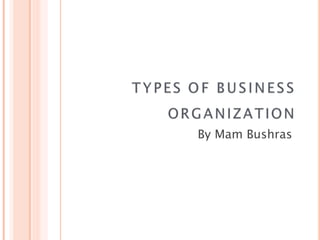
Business Organization s_ 123467890.pptx
- 2. Business Organization: A business is an enterprise which distributes or provides services where other members of the community need and are able and willing to pay for it.
- 3. Purpose of Business Organization: People need to work together to accomplish goals. Goals are too large, too complex, too expensive to be achieved without cooperation. By working together, people can produce more & better goods and services.
- 4. A business organization is classified in to two types. 1. Individualistic institutions 2. Government institutions
- 5. 1. Sole Proprietorship: ‘A sole proprietorship is a form of legal organization in which the owner maintains sole and complete control over the business and is personally liable for business debts’. Unlimited liability of proprietor. The person who contributes capital and manages the business is called as sole proprietor.
- 6. 1. Sole Proprietorship: Characteristics: One man ownership Unlimited liability Enjoyment of entire profit No separate legal entity Simplicity Self employment Secrecy
- 7. 1. Sole Proprietorship: Advantages: Low start-up costs. Freedom from most regulations. Owner has direct control. All profits go to owner. Easy to exit business. Hence efforts and rewards are directly related. Owner’s interest and care directly affects the profit of the business.
- 8. 1. Sole Proprietorship: Disadvantages: Unlimited liability – Owner is entirely responsible for all the liabilities. Death or illness endangers business Total responsibility More difficult to raise finance for business Growth limited to personal energies Personal affairs easily mixed or confused
- 9. 2. Partnership: A partnership is a form of legal organization in which two or more business owners share the management, profit and risk of the business.
- 10. 2. Partnership: Characteristics: Agreement Lawful business Sharing of profits Contractual relations Common management Multiplicity of business (10 for bank and 20 for other)
- 11. 2. Partnership: Advantages: Ease of formation Group talent Wide resources Easier access to finance Sharing of Risk No corporate income tax
- 12. 2. Partnership: Disadvantages: Unlimited personal liability Divided authority and decisions Potential for conflict Continuity of transfer of ownership. Lack of harmony Difficult to get rid of bad partner Death, withdrawal, or bankruptcy of one partner
- 13. 2. Partnership: Types of partners: Active Partners – Authorize to manage the business. Sleeping or Dormant Partners – Just an investor. Nominal Partners – Only lend his name for uplifting the image. Partners by estoppels – Behaviour makes other to believe as a partner. Secret partner – Name not disclosed to outsiders. Minor as a partner – Less than 18.
- 14. 3. Companies: An association of many persons who contribute money / wealth to a common stock and employ it in some trade and also shares the profit and loss.
- 15. 3. Companies: Advantages: Limited liability More stable Easy expansion Democratic setup Large finance Disadvantages: More legal formalities Delayed decision Difficult to maintain secrets. R.Arun Kumar, AP/Mech, RIT
- 16. 3. Companies: Types of companies: Private Limited companies – Minimum paid up capital. Limited companies – Large scale involving huge amount of capital.
- 17. Private Limited Company: A private company is a Companies Act 1956. small concern registered under
- 18. Private Limited Company: For a company to be private limited it must satisfy the features: 1. Minimum paid up capital is 1,00,000. 2. Minimum number of members is 2 and maximum is 50 excluding the past employees. 3. Restricts to transfer the shares. 4. Prohibits public participation.
- 19. Private Limited Company: Advantages: Can be incorporated with just two persons. Facilitates easy formation and easy functioning. No need to file with a registrar to act as a director. Disadvantages: Can’t expect democracy. Exempted from conduction statutory meeting. Can work with only two directors.
- 20. Limited Company: A public company Companies Act 1956. is a large concern registered under
- 21. Limited Company: (Private and Public enterprise) For a company to be private limited it must satisfy the features: 1. Minimum paid up capital is 5,00,000. 2. Minimum number of members is 7 and maximum is unlimited. 3 . No restriction to transfer the shares. 4. Encourages public participation and capital is collected from public. 5. Must have three directors. 6. Should send the financial statement to the members and registrar.
- 22. Cooperative organization: Voluntary association of persons for the mutual benefits and aims are accomplished through self help and collective effort. One for all and all for one.
- 23. Cooperative organization: Every state government has appointed a registrar of cooperative societies for registering, controlling and supervising. Types of cooperative societies: Producer’s cooperative societies. Consumer’s cooperative societies. Farmer’s cooperative societies. Cooperative marketing societies. Cooperative credit societies.
- 24. Cooperative organization: Advantages: Easy to form No obstruction for membership Limited liability Surplus shared by the members Disadvantages: Lack of secrecy Cash trading Excessive government interference Absence of motivation Disputes and differences
- 25. Public Corporation: Autonomous corporate body created by a special state/central government. It acts as a statutory body to serve the general public. act of
- 26. Public Corporation: Advantages: Financed by government. Internal autonomy. Free from government interference. Serves and protects public welfare. Disadvantages: Misuse of power. Lack of interest. Inefficient operation.